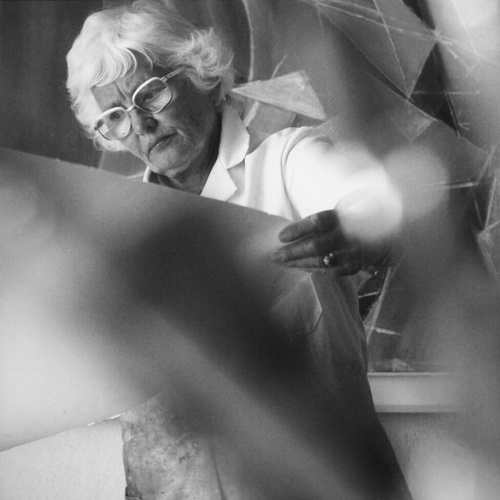Wilhelmina Barns-Graham was closely associated with the St Ives School of artists, key figures in British abstraction and the history of twentieth-century art.
Barns-Graham was born in St Andrews, Fife, to an old landed Stirlingshire family with traditional values. Wilhelmina, known to her friends as Willie, showed a strong creative ability from very early on in her childhood. While in her senior year of St Hilda’s School, Edinburgh, Barns-Graham negotiated the support of her an aunt in her creative pursuit, against the original wishes of her father. She was accepted onto the Painting Diploma at Edinburgh College of Art in 1931.
Barns-Graham was awarded a scholarship in June 1935, with further awards in each of the following five years. This allowed her to keep a studio and continue her studies at the College until 1939. The time was needed as she suffered many setbacks from severe illness, only graduating in 1937. She and her friends, such as William Gear and Margaret Mellis, were acquainted with contemporary developments in London and Paris having visited throughout the 1930s. Though there was another route to be explored. The long-standing Principal of the College, Hubert Wellington, was aware that some of the most advanced talents in Britain had gathered at St Ives in Cornwall to escape the destruction of War. The situation on the continent and Barns-Graham’s poor health suggested to Wellington that this would be a good locale for her, and she arrived in St Ives in March 1940.
The artist occupied a space next to Ben Nicholson and Barbara Hepworth, at No.3 Porthmeor Studios. Though she continued to exhibit at the Summer Exhibitions of the RSA until 1945, Barns-Graham became more involved in the artistic hub that was St Ives. She became acquainted with the ‘primitive’ Alfred Wallis and the autodidakt Sven Berlin. Barns-Graham’s concerns with precise drawing and ordering of shapes and colour were confirmed by these experiences. Through Margaret Mellis and her husband, Adrian Stokes, who were already in the town, she was early introduced to Nicholson, Hepworth and Naum Gabo, the leaders of the modern movement. In 1942 she became a member of the Newlyn and St Ives Societies of Artists, then in 1949 was a founder member of the Penwith Society, along with other artists such as Berlin, Hepworth, Peter Lanyon, Bernard Leach, Denis Mitchell, Nicholson and John Wells.
One visitor to St Ives in 1947 was the aspiring young poet, David Lewis. He met Barns-Graham and despite an age difference of around ten years, the two were married in 1949. The next decade saw the development of Barns-Graham’s development of Modernism. This was generally in-line with that of St Ives School, starting with perception-based abstraction, as in her 'Glacier' paintings of the early '50s, and moving to a free and intensely personal use of the brush. Barns-Graham and her husband travelled widely, meeting contemporaries in Paris and touring Switzerland and Italy. On returning to England in 1956, David Lewis enrolled in the School of Architecture at Leeds. Barns-Graham accompanied him to teach at Leeds School of Art. She did not return for her second lesson, separating from Lewis and moving back South. They were divorced in 1963.
In 1960 Barns-Graham inherited from her aunt, Mary Neish, a family house, Balmungo, near St Andrews, initiating a new phase in her life. She now began to divide her time between St Ives and St Andrews. For the time being the result was loss of recognition in St Ives with a questionable gain in Scotland or in London. Her work did not falter but it changed direction, now employing hard-edged geometric and linear forms. Her capacity to make them serve the purpose of expression was unique. Never static, her forms are always in motion across the surface. These remained the basis of her work for the next two decades. Barns-Graham was not really short of exposure in the 60s and 70s but felt she had lost the commercial edge to other St Ives painters. The memory of the jockeying for advantage in St Ives remained a bitter one all her life. This seemed to be confirmed in 1985 when the Tate Gallery organised a large exhibition St Ives 1939 – 64 showing only three works by Barns-Graham against twenty, for example, by Roger Hilton. However, the event did mark the beginning of a revival in her spirits and fortunes, continued by the retrospective in 1989 at the City Art Centre in Edinburgh, and at Penzance.
Barns-Graham's first solo show was with the Redfern Gallery, also exhibiting with Gimpel Fils and Leicester Galleries and was included in shows at the ICA, AIA, Riverside Museum, New York. She received Honorary Doctorates from St Andrews (1992), Plymouth, Exeter and Heriot Watt Universities and, in 2001, was awarded a CBE.
Her paintings can be found in public collections worldwide including the Royal Collection; British Museum; Tate Gallery; V&A Museum; Arts Council of Great Britain; British Council Collection; Government Art Collection, London; Ferens Art Gallery, Hull; Fitzwilliam Museum; Kettle's Yard; Newhall College; King's College, Cambridge; Birmingham City Museum & Art Gallery; Jerwood Gallery, Hastings; Hepworth Wakefield; Pallant House, Chichester; Dundee Museum and Art Gallery; Scottish National Gallery of Modern Art, Edinburgh; Isle of Man Arts Council; Michigan University Museum, USA; New South Wales Art Gallery, Sydney, Australia; and University of Otago, New Zealand. Her work is also included in the Bank of Scotland, NatWest Bank, Deutsche Bank and Baring Brothers Collections. David Bowie also owned a number of paintings and drawings.
